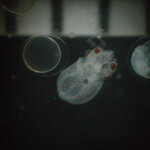Ecology & Zoology

My thesis is now officially half published*! Can we have a party or something?
Marine Ecology Progress Series has just put out my paper, "Effects of temperature on the embryonic development of the Humboldt squid Dosidicus gigas." Or, as I said in the title--Baby Squid Like it Warm.
Just-hatched baby squid next to unfertilized egg.
Ruler increments are millimeters.
That's very small.
Humboldt squid have been invading California, and lands further north, for a decade or two. But the on-again, off-again nature of the invasion, plus the manifest absence of any squid babies in…

At the end of 2011, the second season in a row of a suddenly and mysteriously booming market squid fishery, Michael Vincent McGinnis of the Santa Barbara Independent offers a thoughtful commentary. He makes a particular point of the holistic value of market squid:
The presence and abundance of the squid in California marine areas are of paramount importance to the millions of fishes, birds, and mammals that compete for this resource with human beings. The market squid is a principal forage item for a minimum of 19 species of fishes, 13 species of birds, and six species of mammals. . . . Birds…

The California market squid fishery is about to be closed for the second time in its entire history.
That may sound bad, but it's actually a sign of a booming business. The annual quota for market squid is 118,000 tonnes, a number so high that for years no one was sure it would ever be reached. But just last year, an abundance of squid led the fishery to be closed on December 17th, and this year it's due to close a month earlier: November 18th.
It's worth remembering that this fishery follows a boom-and-bust cycle, and the science behind the squid is poorly understood. Last year I interviewed…

I've been to Tasmania a couple of times; it's certainly a hot spot for squid research. And also, it turns out, for the squid themselves.
The Mercury has brought to my attention that Tassie waters are home to both the world's tiniest squid (the pygmy squid with the glue glands I've been blabbing about) and the world's largest squid (the famous colossal squid). I think that's pretty cool. And since I didn't get to see either species in person, I'll just have to go back. Third time's the charm?

Biodiversity is declining, and is likely to continue along the same path unless something is done about it. And to effectively do something about it, it appears that large investments are required. These substantial investments will probably result in a critical assessment of the science underlying the current and near-future efforts. After all, people and governments like to know where their money goes. This led to a survey among conservation scientists, of which the results have recently been published in the journal Conservation Biology. In the words of the author:
As in the climate-change…

It’s going to be a big day tomorrow when the Oregon football team comes to town. This year, we meet the team that handed us our only loss last season – but on our own turf. And although Stanford has played (mostly) with convincing dominance this season (and Oregon’s already picked up one loss), we’ll take all the home-field advantage we can get.
Sports fans everywhere understand the merits of playing at home: you know the quirks of the stadium, are acclimated to the local weather, and have a fan base that screams at your opponent and shuts up when you’re on offense. It’s the…
(That's glue made by squids, not glue made from squids. Don't be mean.)Yesterday I explained that the little pygmy squid Idiosepius' glue gland produces two different oozes, and so it must be either a duo-gland or an epoxy gland. (By the way, "duo-gland" is a very scientific term. "Epoxy gland" I just made up; glue scientists will probably look at you weirdly if you use it.)
And then I quoted some data from a paper arguing that it is probably an epoxy gland--that is, the two different oozes mix together to form glue.
A little later in the evening, I picked up Mark Norman's…
I've mentioned the Littlest Squid before: the genus Idiosepius, which contains only a handful of very small, very adorable species. And I commented that they have this habit of gluing themselves to seaweed, to hide from predators.
Well, today I'm here to explain how they do it, because a new paper just came out on the topic of itty-bitty squids and their glue organs.
(You can also call them "adhesive organs," but it's a little too general. Technically, the suction cups covering all squid and octopus arms are also adhesive organs! Sure, it's mechanical adhesion--suction--but adhesion…

Ambergris is a weird and wonderful thing. It has been tremendously valuable throughout human history, but its creation and functionality have been shrouded in myth and superstition. To this day, no one has ever seen a whale actually excrete the stuff.
But we know for sure that ambergris comes from sperm whales, because it's been found in their stomachs as well as floating freely in the sea. And since the waxy blobs are always full of squid beaks, we think they're probably the whale's way of dealing with these uncomfortable hard parts.
In general, squid go down pretty smoothly--after all…

Apparently, in the world of Omega-3 supplementation, squid is the new hotness. A Norwegian company producing "Calamarine" has struck deals to sell to a bunch of US food supplements.
It's a nice example of using every part of the buffalo, since the parts they're processing into oil are usually discarded in the process of turning squid into calamari.
But a lot of the enthusiasm seems to be based around the idea that squid fisheries are somehow intrinsically sustainable, which I've expressed some doubt about before. Sure, many squid fisheries are doing better than many tuna fisheries, but that's…